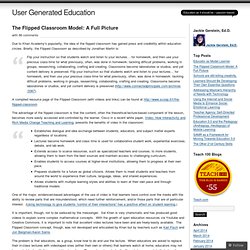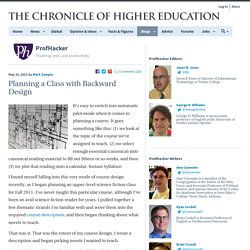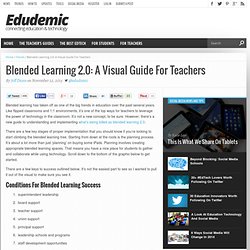

Blooms pyramid teaching-with-technology. Steps to convert traditional course to blended. The Flipped Classroom Model: A Full Picture. Due to Khan Academy’s popularity, the idea of the flipped classroom has gained press and credibility within education circles.

Briefly, the Flipped Classroom as described by Jonathan Martin is: Flip your instruction so that students watch and listen to your lectures… for homework, and then use your precious class-time for what previously, often, was done in homework: tackling difficult problems, working in groups, researching, collaborating, crafting and creating. Classrooms become laboratories or studios, and yet content delivery is preserved. Flip your instruction so that students watch and listen to your lectures… for homework, and then use your precious class-time for what previously, often, was done in homework: tackling difficult problems, working in groups, researching, collaborating, crafting and creating. Classrooms become laboratories or studios, and yet content delivery is preserved ( A compiled resource page of the Flipped Classroom (with videos and links) can be found at. Planning a Class with Backward Design. It’s easy to switch into automatic pilot mode when it comes to planning a course.

It goes something like this: (1) we look at the topic of the course we’re assigned to teach, (2) we select enough essential/canonical/anti-canonical reading material to fill out fifteen or so weeks, and then (3) we plot that reading onto a calendar. Instant Syllabus! I found myself falling into this very mode of course design recently, as I began planning an upper-level science fiction class for Fall 2011. I’ve never taught this particular course, although I’ve been an avid science fiction reader for years. I pulled together a few thematic strands I’m familiar with and wove them into the required course description, and then began thinking about what novels to teach.
That was it. So what’s the problem with this method? In their excellent book Understanding by Design, Grant Wiggins and Jay McTighe call the process of designing courses around learning goals “the backward design process.” Going Hybrid: Where’s a Newbie to Start? How To Get Started With Blended Learning. Blended learning in the classroom is evolving, this much we know.

I can remember back when I was in grade school, the only technical advancement that we had at our disposal was Number Munchers, the computer game designed to teach students basic mathematics skills. Times have certainly changed. Today, blended learning in the classroom is becoming more of a norm than an exception. Grade school students have never known life without the flashy gizmos and gadgets that break down the walls of learning. Mobile devices, slick APIs, social platforms, and the like are ingrained in the psyche of today’s youth – teachers who fail to take advantage of these trends are missing a tremendous opportunity to enrich their learning experiences.
See Also: What Exactly Is Blended Learning? Blended learning approaches don’t have to be overly complicated. The Teacher’s Perspective From the teacher’s perspective, this simple set-up saves hours of time. Leave No Student Behind The Right Balance. How (And Why) Teachers Should Get Started With Blended Learning. Blended learning is quite simply one of the most overused terms to describe the current state of education’s relationship with technology.

However, it fits. Blended learning is marrying the influx of technology with the learning principles that are proven to work. It’s a powerful combination if done properly. That’s why this new-ish term is, as stated just a few sentences ago, such an overused term. Because it’s important! So how does your average everyday teacher get started with blending up your learning? See Also: How Teachers Are Using Blended Learning Right Now Why yes! Blended Learning 2.0: A Visual Guide For Teachers.
Blended learning has taken off as one of the big trends in education over the past several years.

Like flipped classrooms and 1:1 environments, it’s one of the top ways for teachers to leverage the power of technology in the classroom. It’s not a new concept, to be sure. However, there’s a new guide to understanding and implementing what’s being billed as blended learning 2.0. There are a few key stages of proper implementation that you should know if you’re looking to start climbing the blended learning tree. Starting from down at the roots is the planning process. There are a few keys to success outlined below. Conditions For Blended Learning Success superintendent leadershipboard supportteacher supportunion supportprincipal supportleadership schools and programsstaff development opportunitiescommunity engagement and supportprogram management capacitybudget capacity Download the infographic here.